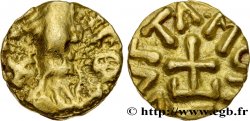Live auction - fwo_407892 - SPANISH NETHERLANDS - DUCHY OF GUELDRE - PHILIP II Réal d’or n.d. Nimègue
You must signin and be an approved bidder to bid, LOGIN TO BID. Accounts are subject to approval and the approval process takes place within 48 hours. Do not wait until the day a sale closes to register. Clicking on "BID" constitutes acceptance of the terms of use of cgb.fr private live auctions.
Bids must be placed in whole Euro amounts only. The sale will start closing at the time stated on the item description; any bids received at the site after the closing time will not be executed. Transmission times may vary and bids could be rejected if you wait until the last second. For further information check the Live auction FAQ
All winning bids are subject to a 18% buyer’s fee.
All winning bids are subject to a 18% buyer’s fee.
| Estimate : | 1 800 € |
| Price : | 950 € |
| Maximum bid : | 950 € |
| End of the sale : | 13 December 2016 18:24:19 |
| bidders : | 1 bidder |
Type : Réal d’or
Date: n.d.
Mint name / Town : Nimègue
Quantity minted : 62892
Metal : gold
Millesimal fineness : 992 ‰
Diameter : 29 mm
Orientation dies : 1 h.
Weight : 5,2_ g.
Rarity : R2
Coments on the condition:
Ce réal d’or est frappé sur un flan légèrement voilé et présente une usure régulière de circulation
Catalogue references :
Obverse
Obverse legend : .PHS. D: G HISPA. ANG. Z. REX. DVX. GEL. +.
Obverse description : Buste cuirassé et couronné de Philippe II à droite.
Obverse translation : (Philippe, par la grâce de Dieu, roi d’Espagne et d’Angleterre, duc de Gueldre).
Reverse
Reverse legend : DOMINVS. MIC-HI. ADIVTOR (CROIX).
Reverse description : Écu couronné écartelé, au 1 contre-écartelé en 1 et 4 de Castille, en 2 et 3 de Léon, au 2 mi-parti d'Aragon et de Sicile, enté en pointe de Grenade, au 3 d'Autriche moderne soutenu de Bourgogne ancien, au 4 de Bourgogne moderne soutenu de Brabant, sur le tout mi-parti de Flandre et de Tyrol.
Reverse translation : (Le Seigneur est mon aide).
Commentary
Cette monnaie, avec le titre de roi d’Angleterre, fut frappée entre 1557 et 1560..








 Report a mistake
Report a mistake Print the page
Print the page Share my selection
Share my selection Ask a question
Ask a question Consign / sell
Consign / sell










